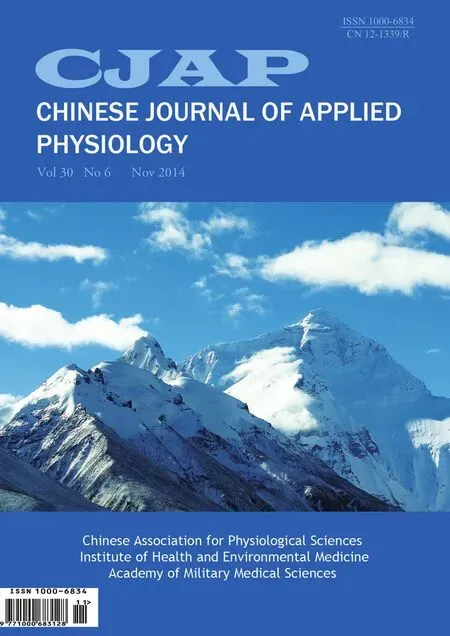Effect of acclimation training on physiological changes in a randomized controlled trial in hot-humid environment
Lei ZHANG, Ying-chun BAO
1. Department of Orthopedics, Nanjing General Hospital of Nanjing Military Command, Nanjing 210002; 2. Department of Military Sports, the Second Military Medical University, Shanghai 200433, China
Introduction
Human need more marine resources in 21stcentury.Abundant oil and gas resources were exported in South China Sea. そe integrated resource rank 4th in the world . With China’s growing development work carried out in the South China Sea, more personnel need to go to the area to carry out construction work.However, South China Sea environmental extremes(according to authoritative summary of meteorological data for 23 years, maximum temperature: 39°C to 46.3°C; mean temperature: 26.28°C to 29.24°C;maximum humidity: 100% to 101.8%; mean humidity: 79.12% to 82.32%) are challenging for us. And so,such toughcondition hinders the construction work process. Because sweating secretion in hot-humidenvironment is ineきcient. We sweat more, but evaporate less, which cause great loss of inner water without obvious decrease of body temperature. And in this situation, human may lost many microelement causing anorexia, hypoxgia, lags in response, more error movements and so on. All these physical changes may finally cause a decrease in working capacity. Therefore, this study was carried out to reduce the adverse eあects caused by hot-humid environment.
The Key point to promote acclimation is to long time exposure in hot environment . In this situation,many adaptation changes may occur such as increase of glycogen and decrease of gluconeogenesis; increase of brown fat tissue and decrease of lipid metabolism;decrease of metabolic rate . そese adaptations reduce physiological strain, improve the individual’s ability to exercise in a warm environment and reduce the incidence of heat illness. そe ways to promote acclimation include psychotherapy, drugs and training . Training is considered the most eあective way and suitable for many people . However, there are limited data on acclimation in extreme hot-humid environment. So this study focuses on the change of physical signs through acclimation training.
Methods
Design
In preliminary experiment, subjects’ work capacity in hot-humid environment reached 85% of that in room temperature environment after 9 days training. So this study consisted of 3 tests in 2 weeks. Experiment I was baseline test that was to test subjects’ 3 000 m-race, reaction time and subjective perception from both groups in two environments. Experiment II was to adapt hot-humid environment including meditation, hot room Fatelaike training run, stepping device training.Many physical signs described below were recorded every day. Experiment III is similar to Experiment I.そe trial was approved by local ethics committees.
Subjects
Five hundred and twelve healthy college student volunteers (all male, 18-23 years) were chosen. Afer testing their 3 000 m-race, 40 subjects (all passed 3 000 m race test because we believed these subjects who had some endurance conditioning might get through our experiment, 21±1.1 years old, BMI 22±3.9 kg/m2)were picked. そey were matched for comparison into experimental group and control group based on their 3 000 m-race grade, reaction time and subjective perception randomly in room temperature environment.そe randomization code was developed by the sponsor, using SAS 8.0 Proc. All subjects were told the risk and benefits. All volunteers signed the informed consent.
Instruments and devices
Analog humid chamber, a hot-humid environment simulation laboratory in the area of 123 M2, 3 meters high, is used which can accommodate 40 people for training. そe highest temperature designed was 46°C by electric heating. 9 temperature sensors made sure the error of temperature inside the laboratory below 0.3°C. The highest humidity designed was 90% by steam from electric boiler. 3 humidity sensors made sure the error below 1%. CO2alarm detector, gas exchange device were installed. The laboratory also has rooms for resting and medical treatment and has passed the State Key Laboratory test.
Treadmill: Self-developed non-powered treadmill,inclination of 15 °, with a Roman table recording mileage. Stepping device: Hydraumatic stepper, ES-011, Donghao Corp., Nanjing, China. The neural response/reaction analyzer STF tester, Tongfang science and technology. Anal temperature sensor WSC-411 digital thermometer, Tongfang science and technology
Experimental procedure
Experiment I: Baseline test
Baseline Test contained 2 tests in hot-humid environment and room temperature environment. Interval time between 2 tests was 3 days. Subjects successively received 2 tests. The order was determined by random number table. そe condition in room temperature was 20°C, humidity 50% and the condition in hot-humid environment was 40°C, humidity 80%. 3 000 m-race time (3 000 m), reaction time (RT) and subjective perception score (SPS) were recorded.
Experiment II: Acclimation training in hot-humid environment
The training was performed every day, and lasted from Oct 15, 2011 to Oct 28, 2011, totally 14 times.The conditions each time was temperature 40°C,humidity 80%, which was similar to average climatic conditions in South China Sea (State Oceanic Administration’s 22 year data). Only the subjects in experimental group were trained. A couple of indicators including blood pressure (BP), heart rate (HR),mean skin temperature (MST), anal temperature(AT), sweat sodium concentration (SSC) and SPS were recorded before and afer each training (Tab.1).
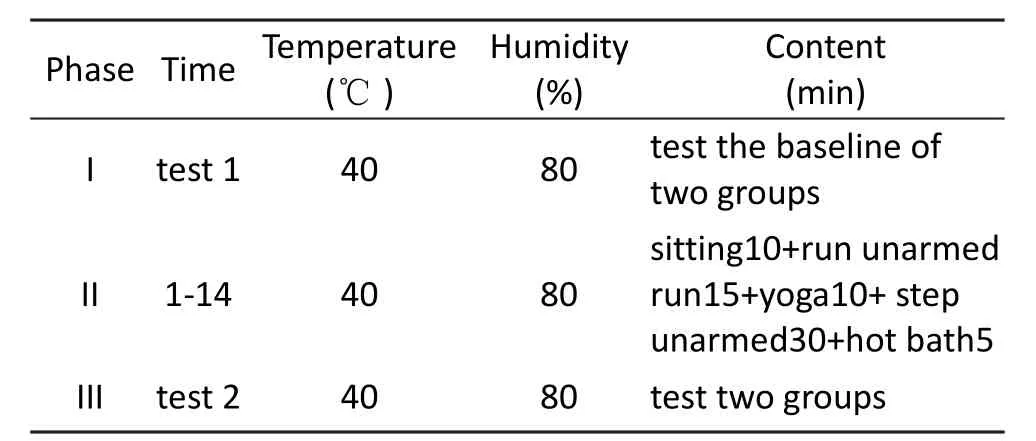
Tab. 1 Training schedule.
Experiment III: Final test
Final test was similar to Experiment I which started 3 days afer Experiment II.
Data acquisition
The investigator, monitor, assessor and the data analyst were blinded to this RCT. そe designer did not take part in test and all data was collected by independent clinical doctors. Every indicator was crosschecked by 2 independent clinical doctors. Another experienced doctor judged when these 2 doctors had diあerence opinions on SPS and this score was the final result.
We collected BP, HR (HEM-6200, Omron Corp.,Japen), MST (forehead, opisthenar, chest, femoral region and gastrocnemius department .MST=0.07×-forehead +0.05×opisthenar,+0.5×chest +0.18×femoral region +0.2×gastrocnemius department) (MT-4 infraed thermometer, Hongxing Corp., Guangzhou,China), SSC (1200 HPLC, Agilent Corp., USA) and SPS (Heatstroke feeling scale excerpted from GJB 2516-96, Tab.2).
Statistics
In Test I, diあerence of measurement data was compared by Paired-Samples T Test with the statistic t.And the diあerence of Graybiel’s grade was analyzed by Wilcoxon symbols rank inspection with the statistic Z.
In Experiment I and II, we drew the line graph to view the trend of all data by excel 2007. All process was done by SAS 8.0. そere was statistically significant whenP<0.05 (2-tailed), and altitude statistically significant whenP<0.01 (2-tailed).
Results
Experiment I: Baseline test
There was no difference in 3 000 m in 2 groups in the same environment, and 3 000 m in hot-humid environment was 76% of that in room temperature environment. そere was also no diあerence in RT in 2 groups in the same environment, and RT in hot-humid environment was over 29% of that in room temperature environment. No difference was observed in SPS between the two group (Tab.3). Results above were no significant difference at baseline in both groups.
Experiment II: Acclimation training in hot-humid environment
AT was lowered during Experiment II. First phase of adjustment was 3 days after training and lasted for 7 days. Plateau was started in 9 days afer training, while the change of MST was not very typically.SSC was lowered during Experiment II. First phase of adjustment was 4 days after training and plateau was started in 10 days afer training. SPS continued todecrease and entered plateau on the 13thdays afer training (Fig.1-3).
Experiment III: Final test
そere was statistically significant diあerence in 3 000 m in 2 groups in room temperature environment.Subjects’ 3 000 m race time in experimental group was obviously shortened than those in control group(t=2.326,P<0.05). It meant that subjects gradually increased the resistance level through our training programme. And subjects’ 3 000 m race time in experimental group was obviously shorten than those in control group in hot-humid environment (t=4.518,P<0.01). Overall, all subjects’ 3 000 m race time in hot-humid environment was 85% of that in room temperature environment.
There was also significant difference in RT in 2 groups in room temperature environment. Subjects’RT in experimental group was shortened than those in control group (Z=11.258,P<0.05). And Subjects’RT in experimental group was sharply shortened than those in control group in hot-humid environment (Z=6.519,P<0.01). Overall, all subjects’ RT in hot-humid environment was over 15% longer than that in room temperature environment. No Differ-ences was observed in SPS in room temperature environment. But subjects’ SPS in experimental group was obviously lowered than those in control group and in hot-humid environment (t=17.958, P<0.01,Tab.4).
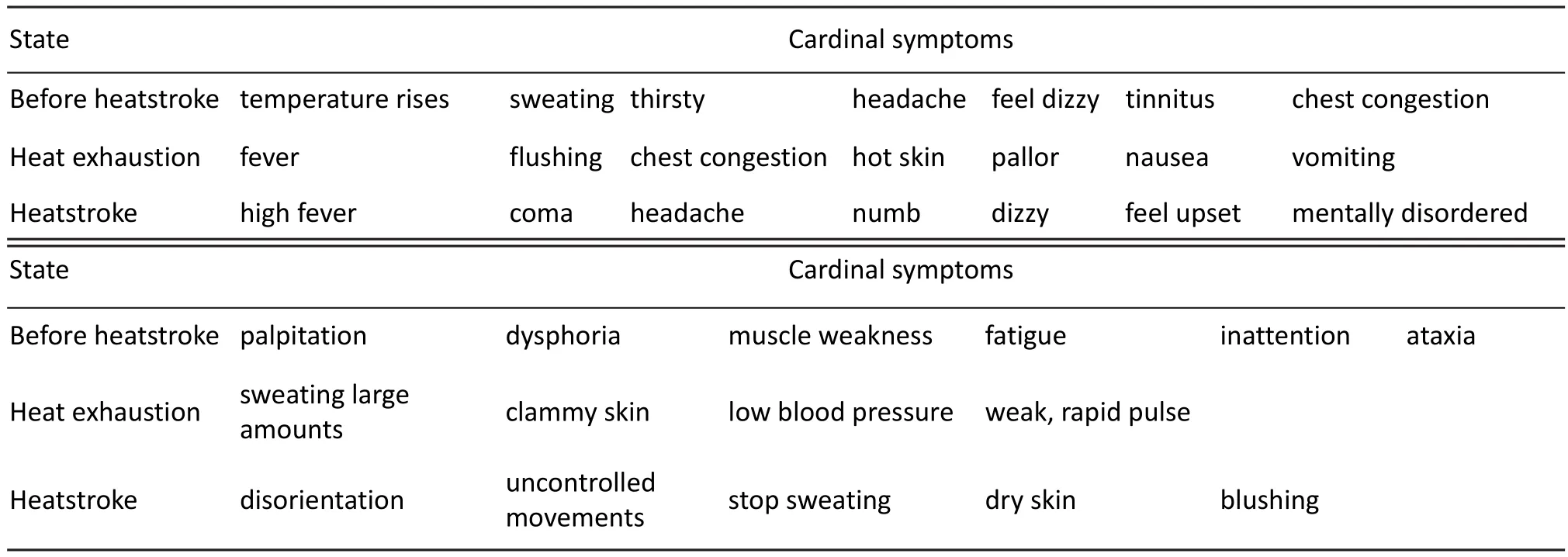
Tab. 2 Brief heatstroke feeling scale excerpted from GJB 2516-96.

Tab. 3 Base line (Experiment I) results.
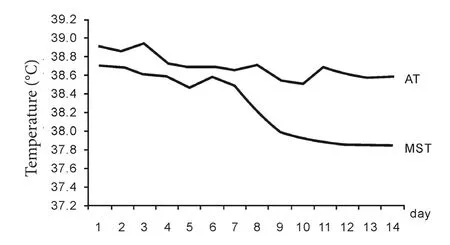
Fig. 1 Anal temperature (AT) and mean skin temperature(MST) change in Experiment II. AT was lowered during Experiment II. First phase of adjustment was 3 days after training and lasted for 7 days. Plateau was started on the 9th day after training, while the change of MST was not very typically.
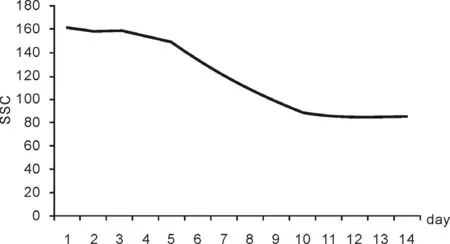
Fig. 2 Sweat sodium concentration (SSC) change in Experiment II. SSC was lowered during Experiment II. First phase of adjustment was 4 days after training and plateau was started on the 10th day after training.
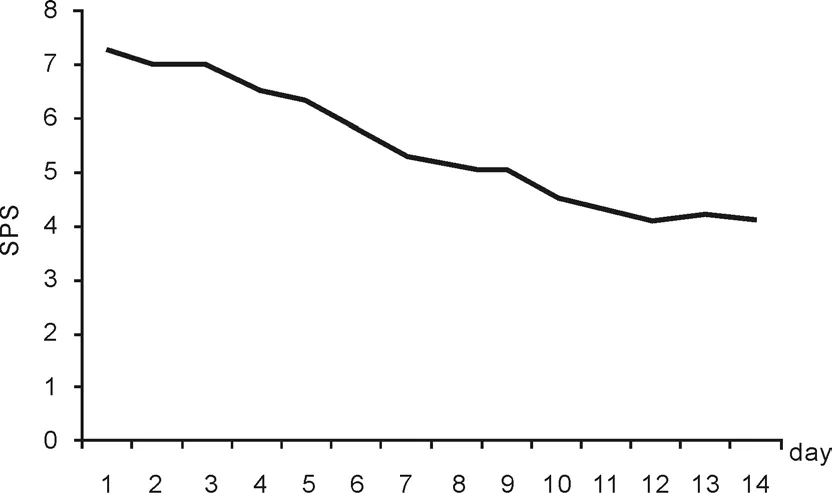
Fig. 3 Subjective perception score (SPS) change in Experiment II. SPS continued to decrease and entered plateau on the 13th day after training.
Discussion
そe main findings of the current study were summarized as follows: (1) acclimation training had obvious eあect on decreasing people’s discomfort in hot-humid environment; (2) people may increase their athletic ability, especially resistance level and nerve reaction,through our training programme; (3) most eあective indexes evaluating people’s adaption to extreme environment in hot-humid environmentwere AT, SSC and SP. そere are a number of factorsaあecting MST,such as dressing, sweat on skin, wind and so on. So it is not easy to grasp the change of MST. And derivate indexes based on MST, such as body heat storage index (BHSI), physiological stress IndexPSI (), were not recommended as proper indexes; (4) AT was the most sensitive, while SSC change was behind AT for 1 or 2 days. SPS decreased all along the training; (5)most subjects had hot-humid acclimation after our 2-week’s training, work ability retained 85 % of that in room temperature environment.

Tab. 4 Experiment III results.
The Standard that we used at present to describe the heat-acclimatized individual has beenimplemented since 1996, in whichthe only measurement index was oral temperature, and training was simple and crude . Chen et al used radioimmunoassay to determine the concentration of MTL (motilin), VIP (vasoactive intestinal peptide) and SS (somatostatin),Yet their results showed no diあerence in MTL, VIP and SS concentration in subjects from control group.But the increase of MTL and decrease of VIP and SS were observed in subjects from experimental group.Subjects who got through training had higher level of CD3+, CD4+CD4+/CD8+and lower level of CD3+/CD8+, CD56+. そeir research concludes suitable heat acclimation can enhance function of gastrointestinal system and cellular immune in the marine training personnel .Dong et al observed the eあect of heat acclimatization on serum Na+, K+, ADH (antidiuretic hormone), and ANP (atrial natriuretic peptide) afer prolonged exercise in a warm environment. そeir results showed rat’s athletic ability improved afer heat acclimation . Zhao et al did animal model and found change of AT and SSC was most suitable to describe heat acclimation . Our data showed that AT, SSC and SPS were suitable for judging acclimation . We did not recommend MST, BHSI and PHI as proper indexes. We had preliminary conclusion but new standard forming needed more subjects and research.
The key point in promoting acclimation was to improve inner temperature within the scope of safe. Related animal experiment showed rabbits had acclimation afer repeat heat expose. Range of AT’s increasing decreased in 11 to 21 days . Besides, time for heat acclimation was connected with overall strength of training . Wu et al investigate changes of thermo-
regulatory responses and hsp70 (heat shock protein 70) in 10-day heat acclimation of middle-long-distance runners, and explore how to establish heat acclimation in practice of training and competing.They found the adaptable changes of body core temperature, heat rate, sweating, hsp70 in 10-day heat acclimation, AT and SSC decreased and hsp increased. They concluded that heat acclimation of middle-long-distance runners successfully came into being if athletes had adaption after 10-day training(60 min, 40% Vmaxevery day) . However, our research lacks some discussion of this mechanism which we may consummate in subsequent research.
1. Zhang J, Jin ZJ, Zhang JC. そe potential and distribution of unconventional oil and gas resources in China[J]. Petrol Petrochem Today, 2004, 12 (10): 17-20.
2. Zhang L, Fang X, Bao YC, et al. Research on motion sickness in hot-humid environment: incidence, prophylactic training and readaption[J]. J Kunming Med Univ, 2011, 12: 26-31.
3. Jason KW Lee, Amanda QX Nio, David CY Fun, et al. Eあects of heat acclimatization on work tolerance and thermoregulation in trained tropical natives[J]. J そerm Biol, 2012, (37): 366-373.
4. Wu XN, Lin JD, Bao YC, et al. Eあects of exercise on urea, lactic acid and electrolytes in human body sweat in humid heat environment[J]. Med J CAPF,2012, 23 (1): 8-10.
5. Armstrong LE, Maresh CM. そe induction and decay of heat acclimatization in trained athletes[J]. Sports Med, 1991, 12: 302-312.
6. Wenger CB. Human adaptation to hot environments. In: Pandolf KB, Burr RE, et al. Textbook of military medicine: medical aspects of harsh environments. Department of the Army, Oきce of the Surgeon General. Borden Institute, 2002: 74-79.
7. Zhang L, Wang F, Qi HX. Research on body temperature used to evaluate safety of training in hot and humid environment[J]. J PLA Inst Phys Educ,2014, 33 (1): 125-128.
8. Bao YC, Wu XN. Research on the hot and humid environment over the sea and its influence on the officers and soldiers of military action and its countermeasures[J]. J PLA Inst Phys Educ, 2014, 33 (1): 112-115.
9. GJB 2516-96 Healthy specification for troops’ heat tolerance training[S].
10. Chen JW, Huang W, Ju JT, et al. Eあects of heat acclimatization on gastrointestinal hormone and cellular immune function of the marine training personnel[J]. Chin Trop Med, 2011, 11 (2): 195-197.
11. Dong R, Feng WP, Zeng FX, et al. Heat acclimatization promotes exercise capacity of rats in a warm environment[J]. Chin J Sports Med, 2012, 31 (11):983-987.
12. Zhao J, Zhu N, Lu SL. Productivity model in hot and humid environment based on heat tolerance time analysis[J]. Building Environ, 2009, 44: 2202-2207.
13. Luo L, Liu XD. Research on the neural response speed in acclimatization training under hot-humid circumstances[J]. J PLA Inst Phys Educ, 2014, 33(1): 123-124.
14. Fang X, Zhang L, Deng Y, et al. Eあects of humid heat environment conditioning on post-training serum K+, Na+concentrations and blood leukocyte count[J]. Acad J Sec Mili Med Univ, 2010, 31(10): 1104-1108.
15. Wang T, Wang J, Wang S, et al. Establishment of heat acclimatization model in rabbits and its pathophysiological characteristics[J]. Chin J Appl Physiol,2013, 29 (5): 473-476.
16. Zhang L, Mao JF, Bao YC. A randomized controlled trial: acclimatization training on the prevention of motion sickness in hot-humid environment[J].Chin J Appl Physiol, 2014, 30 (3): 279-284.
17. Wu WB, Wang RW, Xu DQ. Changes of thermoregulatory responses and HSP70 in 10-day heat acclimation of middle-long-distance runners[J]. Chin Sport Sci, 2013, 33 (9): 46-51.
- 中國應(yīng)用生理學(xué)雜志的其它文章
- Pathophysiological changes in mitochondria of mammalian exposed to hypoxia at high altitude
- A dysfunction of CD4+ T lymphocytes in peripheral immune system of Parkinson’s disease model mice
- Microvesicles derived from hypoxia/reoxygenation-treated human umbilical vein endothelial cells impair relaxation of rat thoracic aortic rings
- Stimulation of endothelial non-neuronal muscarinicreceptor attenuates the progression of atherosclerosis via inhibiting endothelial cells activation
- Scene-trait coping style of military rescuers in Wenchuan earthquake
- Plasma endothelin-1 and nitric oxide correlate withligustrazine alleviation of pulmonary artery hypertension in patients of chronic cor pulmonale from high altitude plateau during acute exacerbation

